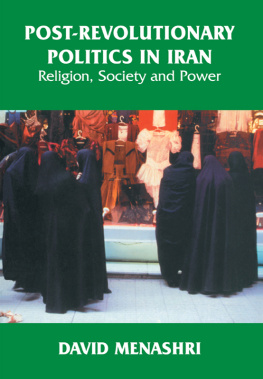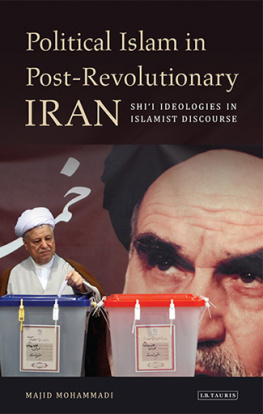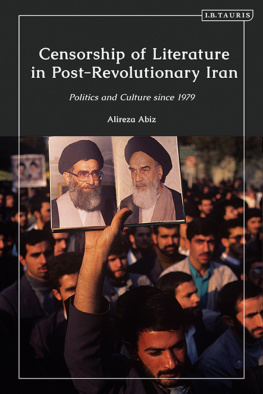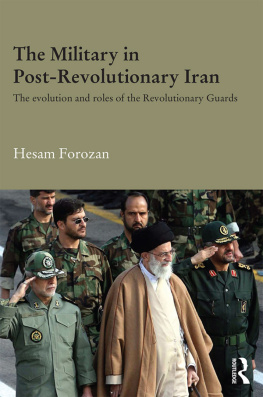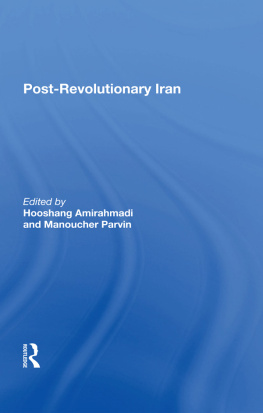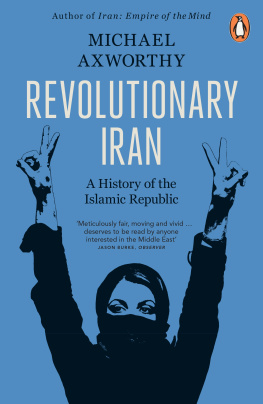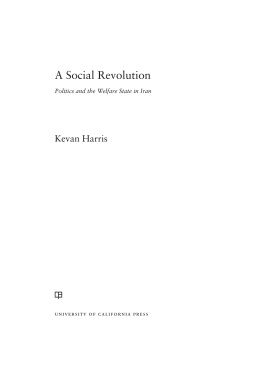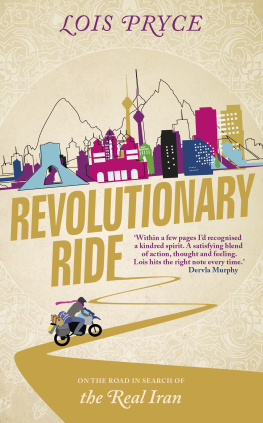For my father, of blessed memory.
First published in 2001 in Great Britain by
Routledge
2 Park Square, Milton Park, Abingdon, Oxon, OX14 4RN
270 Madison Ave, New York NY 10016
Transferred to Digital Printing 2007
Website: www.routledge.com
Copyright 2001 D. Menashri
British Library Cataloguing in Publication Data
Menashri, David
Post-revolutionary politics in Iran: religion, society and power
1. Religion and politics - Iran 2. Iran - Politics and government - 19791997 3. Iran - Politics and government -1997- 4. Iran-Foreign relations-19791997 5. Iran Foreign relations - 1997-
I. Title
320.9'55'09045
ISBN 0-7146-5074-9 (cloth)
ISBN 0-7146-8121-0 (paper)
Library of Congress Cataloging-in-Publication Data
Menashri, David.
Post-revolutionary politics in Iran: religion, society and power / David Menashri.
p. cm.
Includes bibliographical references and index.
ISBN 0-7146-5074-9 (cloth) ISBN 0-7146-8121-0 (paper)
1. Iran Politics and government 19791997. 2. Iran Politics and government 1997- 3. Iran Foreign relations 19791997. 4. Iran Foreign relations - 1997- I. Title.
DS318.825 .M476 2001
955.05'4 dc21 00-050862
All rights reserved. No part of this publication may be reproduced, stored in or introduced into a retrieval system, or transmitted, in any form or by any means, electronic, mechanical, photocopying, recording or otherwise without the prior written permission of the publishers of this book.
Typeset by Regent Typesetting, London
Publisher's Note
The publisher has gone to great lengths to ensure the quality of this reprint but points out that some imperfections in the original may be apparent
Preface
The Islamic Revolution in Iran has undoubtedly been one of the most momentous developments in the modern history of the Middle East. It has led to a dramatic change in the domestic landscape and had a far-reaching influence in the region and far beyond Iran's borders.
Since its outbreak, the revolution has attracted a great deal of public opinion, as well as the interest of scholars, the media and policy-makers worldwide. Some of its unique features, such as mass participation, Ayatollah Ruhollah Khomeini's charismatic leadership, the revolutionary movement's ideology and the politics of the new regime, turned Iran into a focus of public attention from the outset. Thereafter, the process of Islamization, the modus operandi of the clerical regime, the Iran-Iraq war, and the revolution's influence in the Muslim world continued to fascinate observers. More recently, the emergence of President Mohammad Khatami and the wave of reformism have further fired the imagination of observers. Iran's relatively free press, the open domestic debate and deep soul-searching process, the colorful election campaigns (notably to the presidency in 1997 and to the Majlis [parliament] in 2000), and the subsequent countermeasures by the conservative elite, have turned the reformers into the main focus of attention.
More than two decades after the revolution, the Islamic Republic remains in many respects an enigma. The power structure, decision-making process and exact politics of the Islamic regime are far from clear, and the struggle over the revolutionary path is not yet decided. Moreover, at the time of writing, the main developments under discussion seem to have reached a new, more complex and convoluted peak. The principles of the revolutionary philosophy and politics are now being examined in a fierce and open debate about religion and state, Islam and politics, Islam and democracy, state interest versus revolutionary ideology, and Iran's relations with the outside world. This book does not pretend to resolve all such complexities. It strives, however, to shed some additional light on the main processes in post-revolutionary Iran and to try clarify Iran's political landscape.
This book analyzes the developments in the second republic (that is, since the death of Ayatollah Khomeini in 1989) until the end of 1999. The Epilogue, which should be read as an integral part of the discussion, updates the discussion to cover the Majlis elections in early 2000 and the politics of the aftermath of the elections, thus extending the study until the summer of 2000 three years after Khatami's election, and less than a year before the next presidential elections are scheduled.
This study is the result of an ongoing attempt to follow contemporary Iranian politics. Since 1978, I have written all the 22 annual essays on Iran in the Moshe Dayan Center's yearbook, Middle East Contemporary Survey. The opportunity to study such developments in continuum since the revolutionary change in Iran erupted has resulted, I hope, in an intimate familiarity with the Iranian scene, its nuances and vicissitudes over the years. The chapters of the first decade of the revolution have been collected into one volume, Iran: A Decade of War and Revolution (New York, Holmes & Meier Publishers, 1990). This book seeks to provide a comprehensive and updated analysis of the momentous developments in revolutionary Iran in the second republic.
Still, some issues have been deliberately excluded from this study, such as a discussion of the opposition movements, the army and the Revolutionary Guards, and Iran's security concerns and politics. In other cases, only some aspects of more general questions are discussed. Thus, while analyzing the social and political ramifications of the economic situation, this book does not provide a detailed study of the economy. In the field of foreign relations, again, the discussion is limited to certain key questions, while other areas of foreign policy are discussed only briefly.
The convulsions in Iranian domestic landscape make it difficult accurately to identify the competing tendencies. In the early 1990s, domestic differences seemed to revolve essentially among groups usually referred to as pragmatists, radicals and conservatives. Over time, the main actors changed their outlook significantly and the relative power of individual leaders and groups varied considerably. Against a background of such shifting complexities, mapping the domestic forces (in terms of doctrine and association) is not an easy matter. Some of the radicals of the early 1990s turned into the flag-bearers of the reform movement at the end of the decade, and some powerful figures of the early 1990s appeared much weaker only a few years later. Therefore, the portrayal of groups or individuals in terms of policy and influence can relate only to the specific context and period being discussed; and their place in the hierarchy of power should be construed in conjunction with the timeframe and policy areas being examined.
I have used Islamism to denote a phenomenon often referred to as political Islam, radicalism or fundamentalism. Yet Islamism, too, is a problematic term, since it may imply that its dogma represents Islam, or that there is only one interpretation of Islam. However, for convenience, I have preferred to use Islamism. For the sake of consistency, the term Iran is used throughout the book, even for periods in which Persia would have been more appropriate. I have used a simplified system of Persian transliteration, making allowances for pronunciation. I have omitted diacritical marks, yet have retained the

